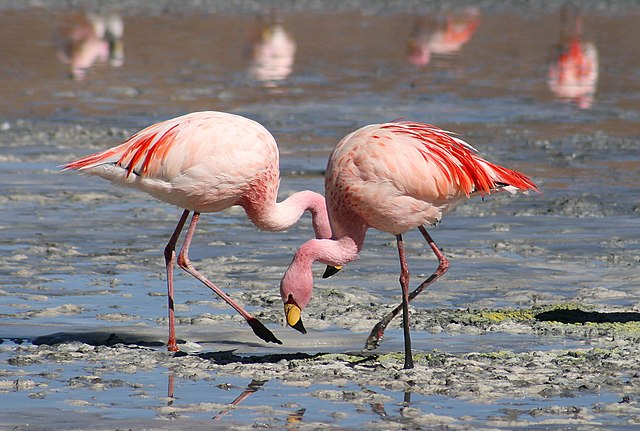Introduction
Flamingos, with their vibrant plumage and graceful presence, have captured the imagination of people worldwide. One question that frequently arises in discussions about these beautiful creatures is whether they can fly. In this article, we will delve into the intriguing world of flamingos and uncover the truth behind their flying capabilities.
Can Flamingos Fly?
The short answer is yes, flamingos can fly. These remarkable birds possess impressive aerial skills that allow them to cover vast distances. Their large wings, usually measuring around 3-5 feet, are essential for their flight. Flamingos primarily use their wings for migration, foraging, and escaping from predators.
The Anatomy of Flight
To comprehend how flamingos soar gracefully through the skies, it’s crucial to understand their unique anatomy. Their long, slender legs and webbed feet aid in navigating both land and water. When preparing for flight, flamingos launch themselves from water bodies by running across the water’s surface using their feet, gaining momentum before taking off.
Their exceptional wingspan, combined with specialized air sacs that help reduce body weight during flight, ensures they can reach impressive speeds and heights. Observing a flock of flamingos flying in a V-formation is a sight to behold, as they effortlessly glide through the air.
LSI Keyword: Flamingo Flight Patterns
Understanding the flight patterns of flamingos can provide valuable insights into their behavior and social dynamics. Flamingos typically fly in large groups, known as flocks, which can consist of hundreds or even thousands of individuals. These flocks serve multiple purposes, such as conserving energy during migration and increasing protection against predators.
Flamingos often form distinctive V-formations while flying. This pattern not only aids in aerodynamics, making flight more efficient, but also helps with communication and coordination within the group. Younger and less experienced flamingos usually follow behind the older, more experienced ones, benefiting from their guidance during migration.
The Great Migration
One of the most remarkable spectacles involving flamingos is their annual migration. These journeys cover hundreds of miles and involve thousands of flamingos traveling together to find better feeding and breeding grounds. Their precise navigation abilities, honed through generations, allow them to return to the same locations year after year.
The migration of flamingos is not only a testament to their physical prowess but also showcases their exceptional adaptability in finding suitable habitats across different regions.
Feeding Habits of Flamingos
Flamingos are filter feeders, meaning they consume small organisms like algae, crustaceans, and small fish from the water. Their specialized beaks act as efficient filtration systems, trapping tiny food particles while allowing water to drain out.
LSI Keyword: Flamingo Diet
The flamingo’s unique diet plays a significant role in its vibrant pink coloration. Certain pigments found in the organisms they consume, called carotenoids, are responsible for the pink hues seen in their feathers. The more carotenoids they consume, the brighter their plumage becomes.
Natural Predators and Defenses
Like any other creature in the wild, they face threats from predators. These include large birds of prey, such as eagles and vultures, as well as some land predators like wildcats and foxes. To protect themselves and their offspring, they have developed several defense mechanisms.
One notable tactic is safety in numbers. Flocking together provides better protection against predators, as there are more eyes to spot danger. Additionally, their synchronized movements and coordinated take-offs make it challenging for predators to single out individuals.
LSI Keyword: Reproduction and Nesting
Flamingo reproduction is a captivating process that involves intricate courtship displays and nest-building rituals. During the breeding season, male flamingos exhibit elaborate dances to attract potential mates. These dances often involve wing-flapping, head-flagging, and vocalizations.
After courtship, they collaborate to build large mud mounds as nests. These nests provide stable platforms for their eggs, usually numbering one or two per pair. The parents take turns incubating the eggs, ensuring a safe and warm environment for their unhatched offspring.
FAQs About Flamingos
Are flamingos monogamous?
No, they are not monogamous. While they do form pair bonds during the breeding season, they often mate with different partners in subsequent seasons.
How do flamingos communicate?
They use a variety of vocalizations, including honking and grunting sounds, to communicate with one another. They also engage in visual displays and synchronized movements to convey messages within the flock.
Do flamingos live in colonies?
Yes, they are highly social birds and are known for living in large colonies. These colonies can consist of thousands of individuals, providing them with safety and support.
What threats do flamingos face in the wild?
Apart from natural predators, they also face threats from human activities, such as habitat destruction, pollution, and disturbance of their nesting sites.
How long do flamingos live?
In the wild, they can live up to 20 to 30 years, while those in captivity may reach 40 years or more.
Why are flamingos pink?
They get their pink coloration from the carotenoid pigments found in the food they eat, such as algae and small crustaceans.
Conclusion
They are truly magnificent creatures, captivating us with their enchanting beauty and remarkable behaviors. From their graceful flight to their vibrant plumage, they continue to intrigue and inspire nature enthusiasts worldwide. So, the next time you wonder, “Can they fly?” you’ll know that not only can they fly, but they do so with elegance and flair, making them one of nature’s most captivating aviators.

